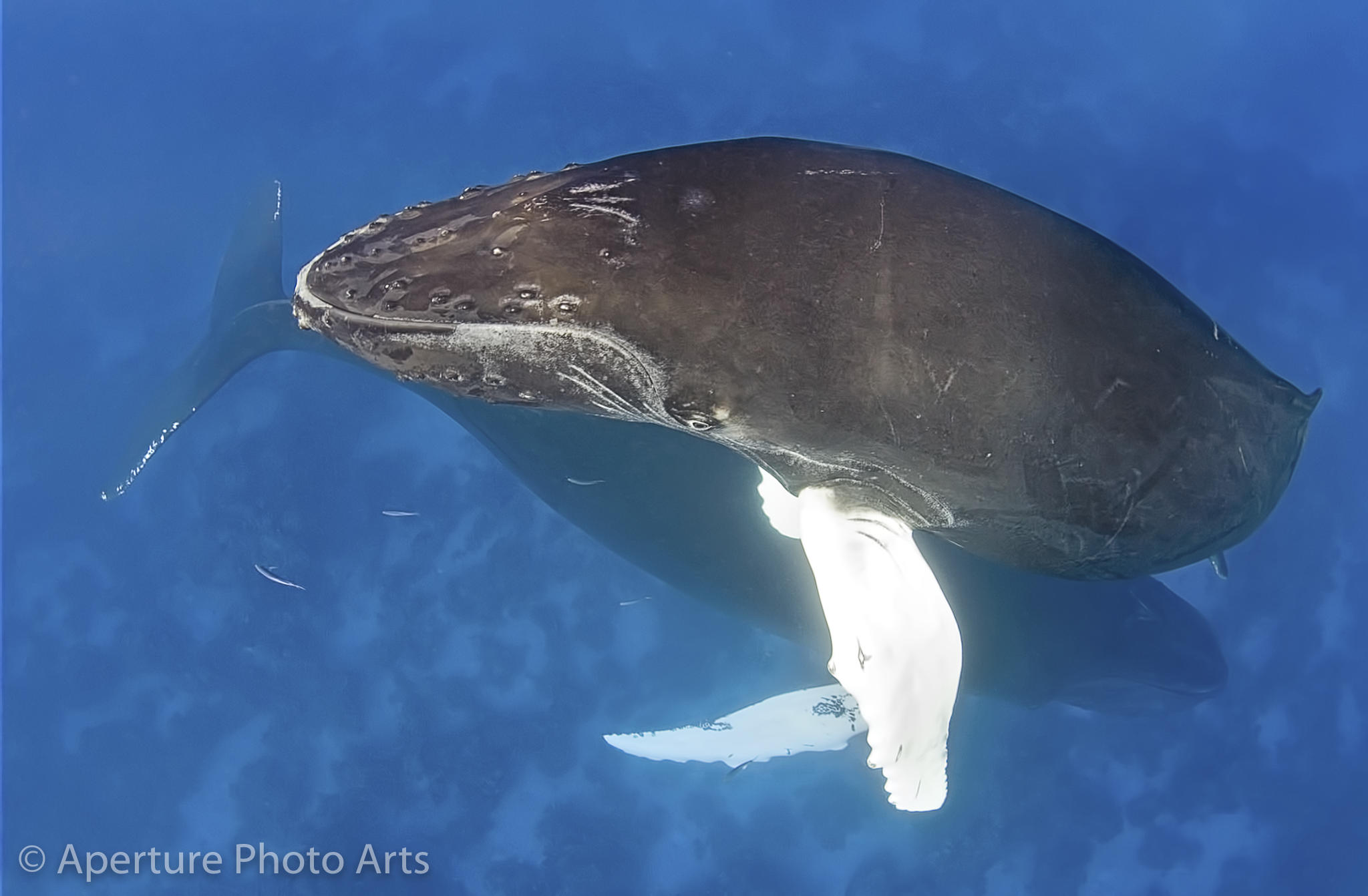
Friday, March 15 and Saturday, March 16, 2019
I rewarded myself with a birthday gift this year, a week devoted to searching for and swimming with humpback whales in Silver Bank, a relatively shallow marine mammal sanctuary, halfway between the Dominican Republic and the Turks and Caicos.
Despite my recent upgrade in status to Platinum on American Airlines, there was no rest or upgrade for this weary soul en route by night to the Dominican Republic after a Friday work day . I had an exit row seat and kept falling, but not staying, asleep on the less than 5 hour flight to Charlotte, NC. I was on my way to rendezvous with a group led by Island Exposure’s Tanya Burnett and her husband Kevin Palmer. We’ve traveled with Tanya and Kevin before, most recently to French Polynesia in September 2018. Hearing this trip was full, except for a single female berth, was all I needed to justify it as a birthday gift to my Pisces self. Perhaps others on the boat had the same idea, as we celebrated 3 birthdays on consecutive evenings.
The day of departure started out rough. Even before the alarm went off, set to allow for riding the bike to work, I could hear my phone sounding off downstairs. It was Fumie, asking the name of the doctor Mama was seeing that morning. This appointment seemed as if it would never come off. Mama had seen a neurologist earlier in the year, who recommended she undergo neuropsychiatric testing to see if her memory issues could be further elucidated.
The first hint of trouble was a call from the office a week before saying they had received a letter from Mama saying she didn’t understand why she had this appointment. This probably was an unsuccessful attempt to cancel the appointment. Thankfully, the office called me, rather than just cancel it.
Mama doesn’t drive the freeways or to Dallas anymore. Fumie does drive but admits to getting lost in Dallas. She was willing to accompany Mama but they needed a ride. Fumie has a cell phone, but was sketchy on calling an Uber. I learned one can order an Uber in advance, remotely, from states away.
Eventually, they safely made it to the correct office and Mama actually had the test. The bad news was she would need to return for the results, a problem for another day.
My trip itself was uneventful. Many of the rest of the group had had to rebook their flights, reflecting the grounding the day before departure of Boeing 737 Max jets, after the 2cd crash in 5 months of this model shortly after take-off. In Charlotte, the American lounge began serving avocado toast at 7 am, instead of the guacamole featured later in the day.
Green Book managed to keep me awake from Charlotte to Puerto Plata; any film that could manage that feat probably deserved its recently garnered Best Picture Oscar.
In POP, as Puerto Plata is designated by airlines, my luggage popped out instantly and there were free and abundant carts. Martín from Isaira Tours was waiting, as arranged at the last minute with Tanya’s help the day prior. Arriving mid-day, I had some hours until boarding at 5 pm at the Ocean World Marina. I knew if I just holed up there and tried to read, I’d just be fighting falling asleep. Continuing to move was my best strategy.
Martín was easy to understand in Spanish, which was a treat. He drove me to El Centro in Puerto Plata, a pleasant square surrounded by historic Victorian-style buildings, including an excellent gelateria, Mariposa.
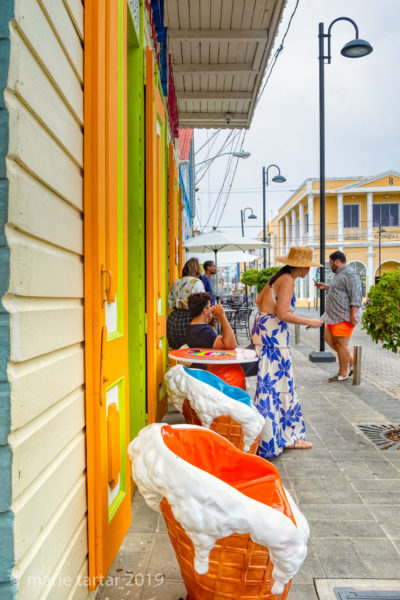
Destination gelatos and sorbets at Heladeria Mariposa, in El Centro of Puerto Plata; dig the ice cream cone chairs in front!
After a terrific lemon sorbet, I enjoyed a second small cup of soursap (guanabana). There were abundant pigeons in the square, being stirred up by a pair of boys zooming around.
I resisted the ice blue lure of the larimar stone in several shops, as well as the golden siren calls of the abundant amber. Our final stop was the Forteleza de San Felipe, dating to the 1600s and built as a defense against pirates.
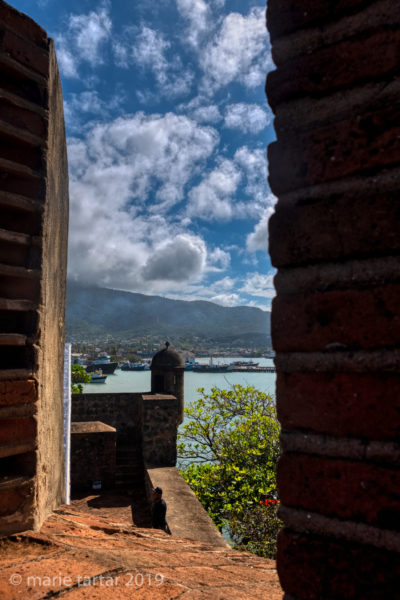
Forteleza de San Felipe was built as a defense against pirates and was later employed as a prison by the notorious dictator, Rapheal Trujillo.
At the marina, I ran into Kevin chatting with a deeply tanned man who turned out to be the permit holder/leader of our prior trip 12 years before, Tom Conlin of Aquatic Adventures. Our group assembled in dribs and drabs during the afternoon and included several family groups. I first met Ivo and birthday girl Reynilde from Belgium on The Terrace. I enjoyed speaking French with them during the week, especially after discovery of our mutual love of cinema.
Bradford was accompanied by his teenage daughter Caroline, his sister Lindsey and girlfriend Cindi. Dave and Amy are avid divers from Colorado, part owners of Damai (a boutique dive boat operation in Indonesia) and were celebrating their 30th wedding anniversary with this trip. Rounding out our group was an extended family and friends group, at the center of which is Ruth, a lively septuagenarium and her younger cousin Miles, a NOVA filmmaker from Boston. Miles was accompanied by his girlfriend Suzi, and Ruth by a trio of South Florida blonds, Ivi, Terri and Kim, plus a younger friend, Lisa. Lisa was my roommate, considerate and quiet, with a droll sense of humor.
A typical exchange:
Me (exiting the bathroom): “Lisa, it’s 11 after 7 (am).”
(Our charge was to be dressed and finished with breakfast by 8 am.)
Lisa (muffled, from under the covers): “I’m in denial.”
Steve and I were here 12 years ago, with our friends Bob, Debbie, Nancy and Gerry, on a now decommissioned boat, the boxy and ugly Nekton Pilot, which resembled a monstrous platform shoe on the water. From the moment we disembarked, I have wanted to return to Silver Bank, where Northern Atlantic humpback whales congregate every winter from January to March to give birth and nurse newborn calves into a sufficient size to migrate to Northeast coastal fishing grounds. Courtship also takes place here, with male humpbacks called escorts cozying up to mother and calf pairs, trying to insert themselves into the future mating picture.
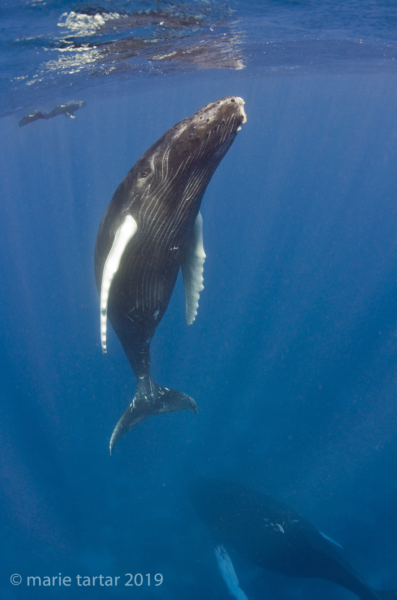
From our trip in 2007 with Bob, Debbie, Nancy and Gerry, a humpback calf heads to the surface for a breath and to check out the bobbing swimmers above, while its mother rests below.
Despite spending considerable time in the ocean diving, it is rare to actually see a whale underwater. The first time I recall being spellbound by humpback whales was on a kayak camping trip in Glacier Bay in Alaska in the mid-1990s. We were on the water, surrounded by the goliaths, listening intently for their blows and trying to guess where around us they would next emerge. Camping on a beach that night, they remained just off-shore, where we could hear them blowing all night long.
As recently as January in Antarctica, we were entranced by abundant humpbacks feeding as we roamed an iceberg field in zodiacs.
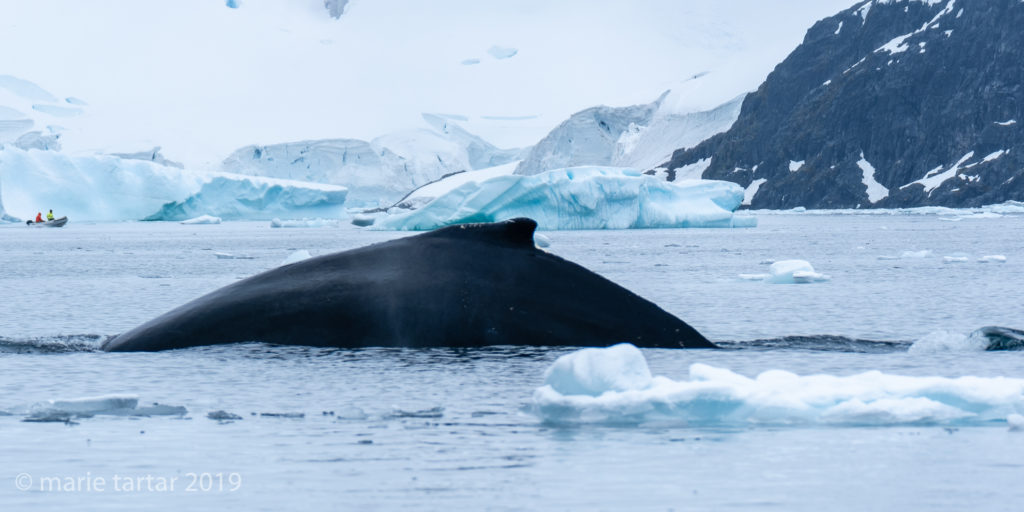
Humpback, Antarctica, January 2019: I’ve heard 2 explanations for the name humpback. One refers to a variable protuberance seen in front of the dorsal fin (also seen in the following photo). The other references how these whales round their backs when diving down.
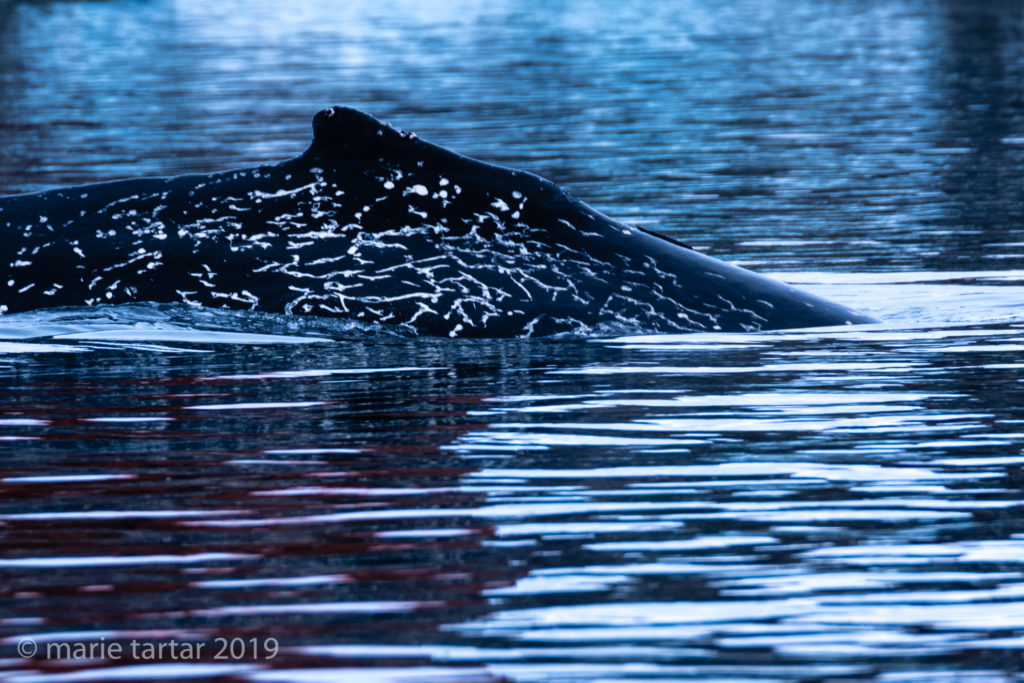
This humpback feeding in Antarctica shows an unusual pattern of skin mottling which I’ve never seen before.
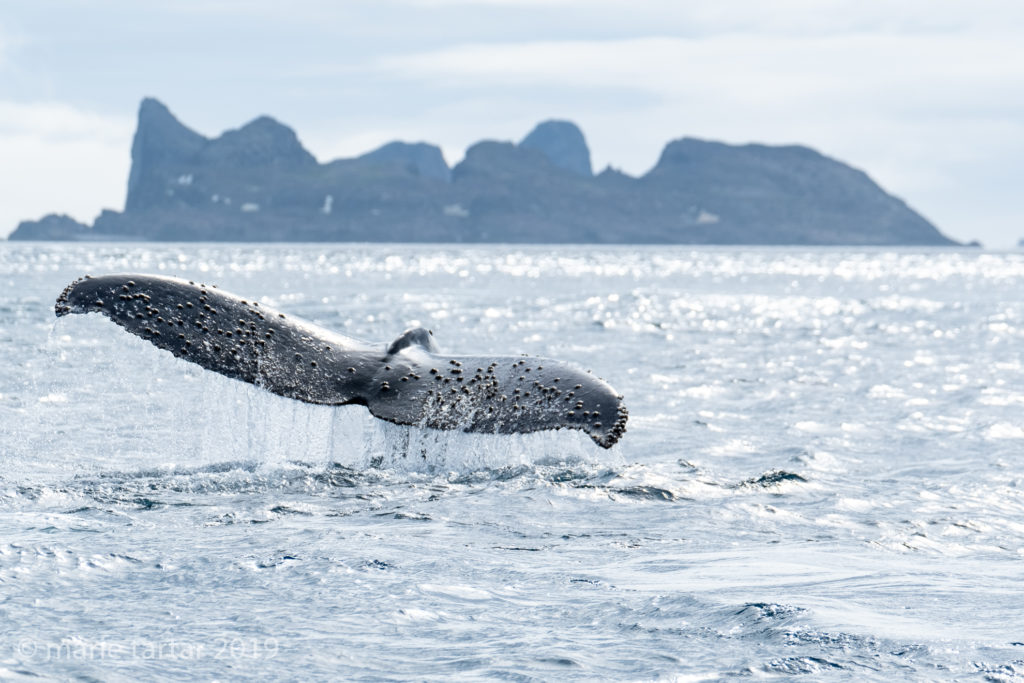
We had a lot of close sightings of feeding humpbacks in Antarctica, but mostly backs and flukes (tails).

The bumps (tubercles) are characteristic of humpbacks and are the whale equivalent of a hair follicle.
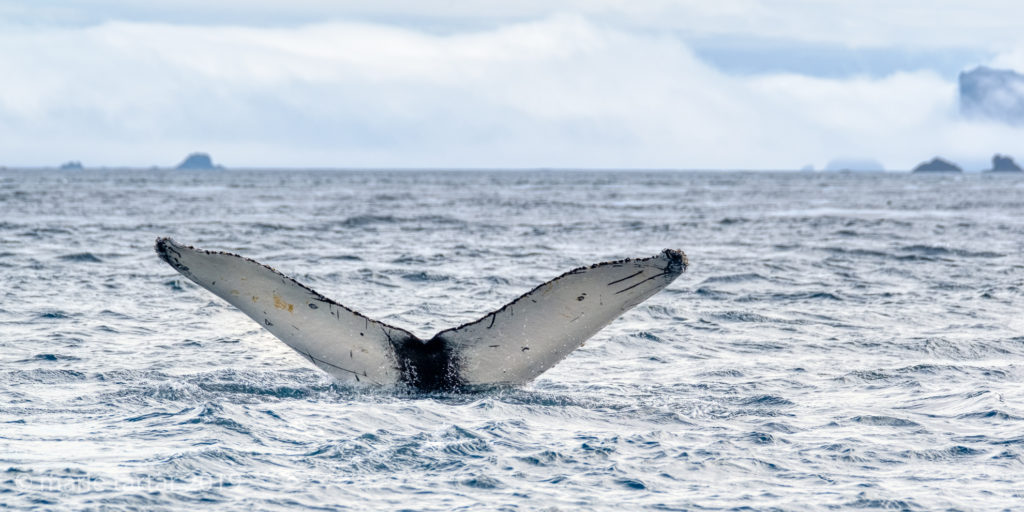
Humpback fluke underside markings are as unique as a fingerprint and are used to identify individual whales.
Sunday, March 17, 2019
Captain Gene Flipse (a Dutch name) and Ben Vieyra joined us this morning. They had been assisting a private vessel over the weekend . They were our whale experts and guides for the week. Gene briefed us on the loading procedures, transferring from the mother ship to the tenders, which can be “sporty” in bigger seas when the tender and the ship pitch and strain against each other.
This is Gene’s 17th season, 11th as permit-holder for Conscious Breath Adventures. The Sanctuario de Mamíferos Marinos De la Republica Dominicana is actually in the southwest corner of the North Atlantic and not in Caribbean Sea. The sanctuary was established in 1986 and expanded in 1996 and includes just under 40,000 square miles. There are thought to be 2000-3000 humpback whales in Silver Bank, which is mostly 80-90 feet in depth.
The name Silver Bank, depending on the source consulted, may refer to the sometimes silvery appearance of the sun or the full moon on the water, or possibly references treasure rumored lost in sunken Spanish galleons. We were in search of a different sort of treasure, namely soft in water encounters on snorkel with humpback whales. Most of these encounters are with mother and calf pairs, sometimes with an accompanying male suitor called an escort. Adults humpback whales can stay submerged for up to 20 minutes or so, while calves must breath more often, every 3-7 minutes.
Gene emphasized that it is “more important to be quiet than fast” in approaching whales, avoiding the “paddle-wheeler effect “ of a line of people splashing up to whales.
Our first venture into the water in the afternoon, with Tanya and Ben, was mostly a bust, with many sightings, even breachings, but too distant or not cooperative enough. After our “check out” swim, we suited up twice, ready to go, while Ben swam out and confirmed there were whales down below, signaled by an upraised arm. But before we were even in the water, the whales moved off. The other group, with Gene and Kevin, fared better, with one brief encounter with a “singer”, a male in the depths, head down, pouring out a bone-vibrating song.
Thankfully, the procedure for entering the water on Gene’s boats, Pec and Fluke, is much easier and more comfortable than on our prior trip. We sit along the rail, with our masks and fins on and fins up above the water, until the signal is given and we slide as quietly as possible feet-first into the sea.
The position required on our prior trip was a particular torture for me. Early in that trip, I knocked into the boat just after sliding into the water. I was fiddling with my camera and not paying attention to the fact that a wave was pushing me toward the boat. A focal impact on my ribcage broke a rib, which I could feel moving with each breath for the rest of the trip. Rolling over in bed was agony. Kneeling on the gunnel of the boat and holding the heavy-out-of-water camera suspended, until the signal to slide headfirst into the water was given, was excruciating.
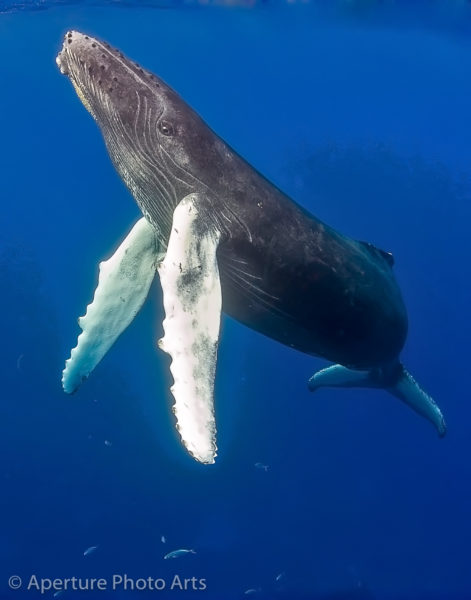
Despite the injuries we sustained on our 2007 trip, we did have a few close swim-bys of curious calves.
Up on the sundeck at cocktail hour, the presence or absence of the green flash at sunset was the subject of lively debate.
Yet another cake appeared after dinner, as it was boat driver Alex’s birthday. To mark the occasion, he promised to shave off his bushy red beard, but by week’s end, I could see no discernible change.
Monday, March 18, 2019
The days have a predictable rhythm, slowly prowling through the bank, with waves slapping the side of the boat, listening and looking for blows in every direction. Once a blow is sighted, we watch in that direction for repeated blows, revealing the number of whales. Unless a whale breeches, the sightings themselves are brief glimpses of an arched back and a dorsal fin. Blows that appear relatively close merit investigation, prompting the boat driver (alternating between Dennis, red-bearded Alex and Simon) to nudge the boat in that direction. The boat is slowed as we approach, so as not to scare off the whales, who reportedly can be spooked even by dropping a weight on the boat deck. We also try to enter as quietly as possible, with minimal splashing. Even swimming toward the guide, with arm upraised so we can see him, we try to swim sideways, forcing our fins underwater and minimizing noisy splashing.
We did find a mother and calf pair. The A group waited anxiously for our turn as we could see the calf appearing very playful for the B group, who stayed through 2 maddeningly long breath cycles. Ben took me to task for drifting ahead of the line. One second he was at my right shoulder, then next he was 10 feet behind me. I didn’t kick, but just laying on the water trying to see through the viewfinder can push one out of the desired position, which is in a line facing the same way.

Curious humpback calf making social rounds, checking out Ben (long fins) and Tanya: trying to maintain distance and stay shoulder to shoulder while looking through a viewfinder is harder than it sounds.
Our compensation was racing alongside an exciting heat run of “rowdies”, a competitive group of males posturing for a female’s favor as a mate.
Tanya stuck her camera below the water’s surface to confirm 7 whales in the pack. Experience it vicariously here: https://vimeo.com/326735055
After lunch, the other group found a singer, so we joined them and began swapping places with other group. We could indeed hear the singing in the boat and feel the vibrato of the mysterious tones reverberating through our bodies.
For the 3rd night in a row, there was birthday cake for dessert, tonight for Kevin’s 60th birthday.
Thanks to Mile’s satellite phone, I had a chance after dinner. to check up on Steve at home and was relieved to learn he wouldn’t be undergoing a cardiac arrhythmia ablation procedure while I was away.
Tuesday, March 19, 2019
This is the A team’s first outing with Gene, the permit holder. He has been running trips here as Conscious Breath Adventures for 11 years, starting just after our last trip here.
At that time, Tom Conlin of Aquatic Adventures had been running trips for 17 years. There had never been a serious injury, until just 2 weeks before our 2007 trip. Apparently, a group drifted in from the upwind side over a resting mother and calf pair. The calf woke up and started, spooking the mother, who took off. A flick of her tail was sufficient to fracture a femur and concuss another swimmer. Since then, upwind encounters are no longer allowed. Gene, setting up his nascent company, happened to call for insurance coverage on the very day the company had just learned of this unprecedented accident.
Other than this accident, which could definitely be called a fluke, swimming with humpbacks isn’t particularly dangerous. There are the usual hazards of boats (Steve injured a toe on the same prior trip as my rib fracture), but humpbacks themselves are baleen whales, engulfing large quantities of sea water containing tiny nutritious krill and small schooling fish. The nutrients are filtered by baleen plates and the water expelled. Humpbacks are second in size only to the blue whale. Adults approximate a school bus in length (up to 60 feet). Even the calves are up to 20 feet in length.
We had close but brief encounters with mother and calf pairs this morning.
The first was the best, with clear curiosity about us displayed by both calf and mother, but Gene lost sight of them as they repositioned. The choppier water made it harder to track whales. Once we see a blow, a timer is set to measure the interval until the next.
Back on board the Belize Aggressor IV for lunch, I couldn’t understand why my battery was dead on arrival. Once I downloaded, the reason was clear: I inadvertently left the video on, resulting in a 23 minute long segment, including footage of a mother and calf pair, the swim back to the boat, loading back into the boat, a spell on the deck and then back into the water. Too bad most of this was unfocused and completely unintentional.
We never entered the water in the afternoon, but tracked a mother and calf accompanied by an escort, which kept the pair on the run. The calf put on quite a show, repeatedly breaching, seeming to kick up its aquatic heels, over and over.
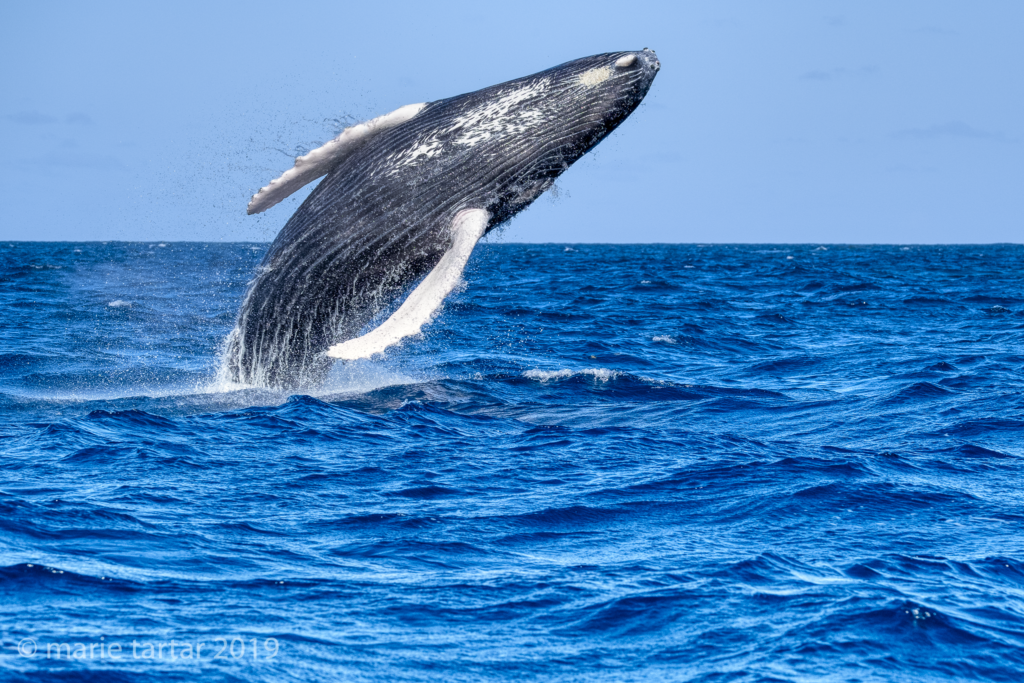
Humpback can eject their bodies full-length out of the water. Why do whales breach? Theories range from ridding themselves of parasites to just for the fun of it. We certainly enjoyed this exuberant display.
At the early evening sundowner, a steeply arcing flight trail led to wild speculation. Miles, with his authoritative newsman demeanor, had everyone believing it was a rocket launch from Cape Canaveral, until Tanya blew up a shot to reveal a FedEx plane.
Wednesday, March 20, 2019
I awoke transformed and not for the better. My sunburned lower lip had blown up overnight to 3X normal size, not a pretty sight. Tanya was my lip sistah, with a milder case. Suzi came to my rescue with a lip balm with sunscreen.
The A team started and ended this morning with a pec slapping escort bookending our morning. Pec slapping occurs on the surface when a humpback whale winds up one or both of their huge pectoral fins and flings it at the water’s surface, generating a resounding smack which can undoubtedly be heard underwater a good distance away.
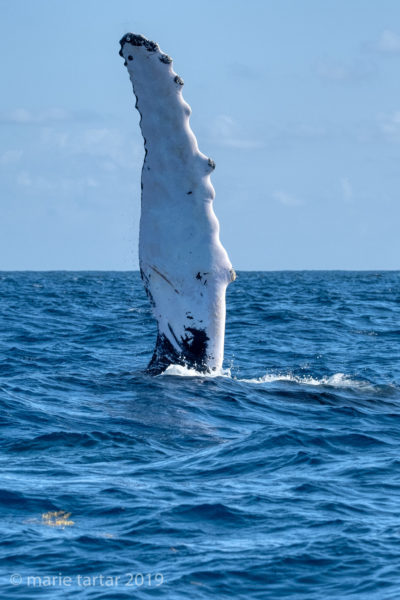
The humpback’s scientific name, Megaptera novaeangliae, means long-winged New Englander and refers to their pectoral fins, which can reach 5-6 meters in length, a third of their body length. We had encounters at times too close for a 100mm lens!
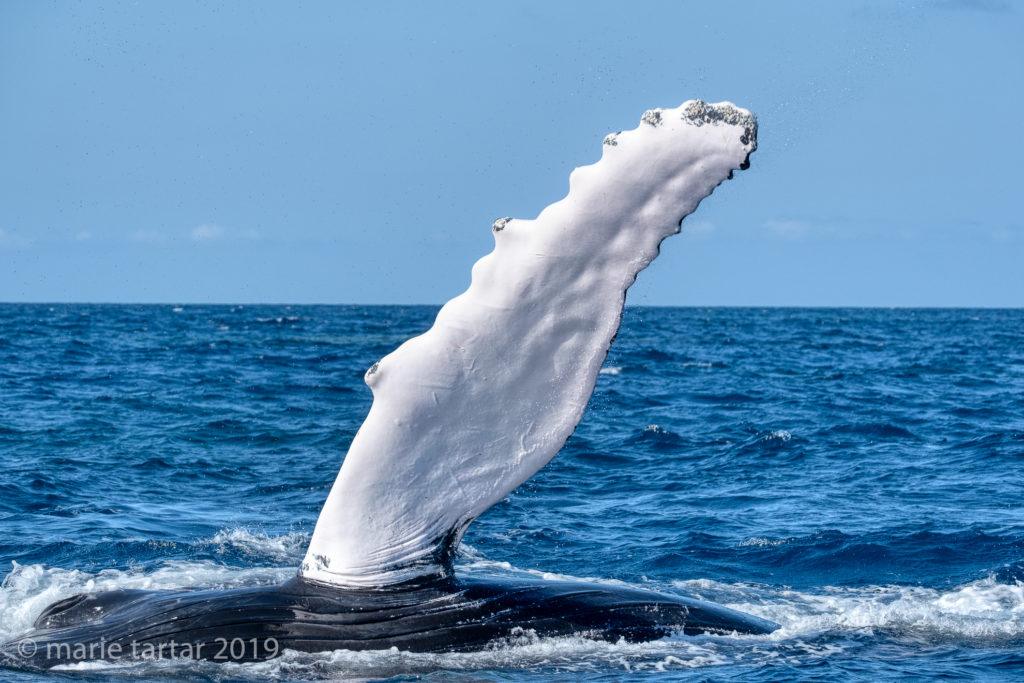
Silver Bank humpback whale pectoral fin makes a resounding THWAAK when it strikes the water’s surface!
This behavior, which I had never seen at such close range, is thought to be a means by which humpbacks signal each other. Perhaps the escort, a male hopeful of mating with a female, is warning off potential rivals? In our case, we wondered if this escort was annoyed by our persistent attention and signaling displeasure. Our exuberant whoops and hollering were momentarily checked by Miles’ periodic pleading for “Quiet on the set!”, as he endeavored to capture some footage of the action with natural sounds. Check it out here: https://vimeo.com/328860162
In the afternoon, with Simon at the helm of the boat, we had to settle for fly-bys. Some mother and calf pairs are more tolerant of our presence than others and may permit prolonged encounters; others stay on the move and reposition with each breath cycle. The other group joined us after a few drops and we alternated with them until the end of session. The mother and calf slept at the final encounter; eyes closed, hovering just below the surface.
Thursday, March 21, 2019
Kevin, on other boat, forgot his mask and snorkel. Our boat came to the rescue, swinging back by the mother ship to pick up his gear and run it out to him. Of course, he came in for some age-related ribbing, citing his recent promotion to senior citizen status.
Both boats spent the entire day with a trio of mother, calf and a remarkably mellow and tolerant escort. In the morning, we jumped into the water I-don’t know-how-many-times, staying out until lunch was cold hamburger pucks at 2 pm. The other boat joined us, taking turns in the water in sessions timed to the mother’s breath cycle. The mother coming up for a breath signaled the end of a session, with swimmers exchanged after she descended. One of our turns was aborted by the calf, which breached and took off, causing the mother to have to chase after it. Unfortunately, this happened just after Gene signaled us into the water, as we jumped in. He saw what happened and motioned that we should hold up, but we were already in the water, eager to go.
After lunchtime came and went, Gene invited a boat from the Turks and Caicos Aggressor to “babysit” the family group, swimming with the trio while we headed to lunch. We were back out on the water after a quick lunch for 3 more sessions. The calf was not curious about us and more inclined to speed back down to the safety of mom’s shelter down below. Our A team, led today by Gene, of Ruthie, Miles, Renilde, Ivo, Lisa, and Tanya, became expert at loading ourselves onto the rail and reboarding the boat. With Lisa serving as a barcalounger stabilizer behind Ruthie, Tanya in the water would expertly extract the fin from Ruth’s prosthetic foot, enabling her to mount the ladder with assistance. Each boat driver had his own method for helping her surmount the top rung, with Dennis having her mount his back piggyback-style to move onto the boat. I had to chuckle the first time I heard Ruth ask Ivo, near her gear bin, to “hand me my foot”. She swaps out a “land” foot for an aquatic one before going in the water. Despite having lost an arm to a crush injury at work, Miles was ably to nimbly mount the rail and scale the ladder without any assistance, GoPro in tow.
Friday, March 22, 2019
Our crossing back was smooth. A break from the tedium of packing was provided by an advanced screening of Miles and Susie’s NOVA film on the Paradise wildfire, called Inside the Megafire, set to air on PBS TV on May 8. This fascinating documentary on the effects of forest management, climate change and rising incidence of megafires in California and elsewhere is well worth a watch.
Arriving back at the marina in Puerto Plata, a pre-dinner screening of Gene’s video and Ben’s slideshow of our encounters during the week enabled us to relive a memorable week. Compared with our prior trip, this one was more varied in terms of in water encounters and much more successful in terms of surface behavior photography. The conditions were challenging, with frequently poor water visibility; but for the white of the humpbacks pectoral fins, it would have been near impossible to focus when they were down below.
The Conscious Breath Adventures (CBA) tradition is to end the week eating out at an open air, garden setting restaurant called Le Papillon (The Butterfly), which owner Tomas closes each Friday night for CBA. At a huge long table, we were joined by a Seahunter representative (CBA will be using their boat starting next season), as well as several guests joining the next week’s trip. One guest, Joan, has been out with Gene and CBA every year for 1-3 weeks as a citizen scientist.
Saturday, March 23, 2019
The grounding of Boeing 737 MAX 8 and subsequent reshuffling of flights led to the Florida contingent of Ruth, Ivi, Kim , Terri and Lisa having to rise in the middle of inky night to make a 7 am flight. Ivo and Renilde and Kevin and Tanya were staying on land for a few additional days. On my incoming tour, Martín told me about his north coastal village, Sosúa, and mentioned it was the site of the largest Jewish settlement in the DR. This intriguing history, his easy to understand Spanish and my having a morning free before a midday departure prompted me to book him for another tour prior to being deposited at the airport. This gave me a chance to discuss the Mario Vargas Llosa book I read recently in preparation for this trip, La Fiesta del Chivo or The Feast of the Goat. The Goat is Rapheal Trujillo, the dictator who ruled the DR for 3 decades until his assassination in 1961. The book is fiction but depicts actual events using real and imagined characters. Martín assured me the bulk of the depiction was accurate.

On my tour, he took me by a memorial to the Mirabal sisters, whose killing features in the book and in history as an camelback-breaking event inciting the conspiracy to assassinate Trujillo. Three of the four sisters (Minerva, Patria and Maria Teresa) came to Puerto Plata to visit their husbands, who had been arrested for opposing the regime. They were imprisoned in the Forteleza de San Felipe, which I visited on my way in. The sisters’ car was ambushed on their return by Trujillo’s secret police. They were brutally murdered, as was their driver, and their bodies were sent in the car off a cliff in a feeble attempt to disguise the killing.

This monument in Puerto Plata is dedicated to the memory of the Mirabal sisters, who were brutally murdered by the Trujillo secret police, who tried to cover up the crime by staging an automobile accident afterwards. Their murder is cited in The Feast of the Goat as an inciting event leading to the assassination of Trujillo in 1961. The women were known as Las Mariposas (Butterflies) in the anti-Trujillo resistance movement. The monument is by architect Sarah Garcia. The date of their murders, November 25 (1960) is now recognized by the UN as the International Day for the Elimination of Violence against Women.
Today, the sisters are revered for their leadership and martyrdom. The 3 murdered sisters are depicted on the 200 Dominican peso bill. The remaining sister, Dedé, raised their 6 children and devoted the rest of her life to the legacy of her sisters. The family home is now a museum and the sisters are commemorated throughout the DR.
Sosúa itself is a prosperous seaside enclave, with attractive beaches, pricy housing and resorts and a population including considerable numbers of Russian and German expats and second home owners. The Jewish Museum itself was closed, but evidence of the local Jewish community was seen in dedications at seaside parks. It’s surprising, but one good deed of Trujillo was to permit the immigration during the Second World War of hundreds of Jews fleeing Europe. (From all accounts, it’s doubtful this was purely altruistic; distracting the world from the Haitian genocide of 1938 may have been a prime motivator.) Sosúa was at the time an abandoned banana plantation and with the aid of DORSA (Dominican Republic Settlement Association), emigrés were provided with land, farm animals and a seed money loan to form an agricultural collective. This endeavor didn’t make it, but a subsequent food-related enterprise, making sausages, cheeses and related products, is a thriving enterprise even today.

75th anniversary of the arrival of the Jews to Sosúa. The Dominican Republic was nearly alone in offering visas to Jews fleeing war-torn Europe in WW II.
Back at the airport, after perusing the appalling offerings of the Priority Pass lounge and passing, I ran into Bradford, Cindi, Caroline and Lindsey and had a passable Cubano panini lunch with them before boarding our flight to Charlotte. I continued my catch up on the Academy Award Best Picture nominees with Bohemian Rhapsody (Rami Malek deserved that Best Actor Oscar!) on the ride home.
It was a long day, boarding my cross country flight home after 8 pm. Happily, I was ungraded for this leg, easing the way home. Poor Steve was stuck in the cell phone lot for 45 minutes while my bag took an interminably long time to appear. We had a lot to catch up on, he being off at home for the week, installing new shelving in our dumbwaiter turned storage closet and rearranging the artwork, somehow managing to find a home for his huge Our Lady of the Bottle piece. Boxed up, it had been taking up a ridiculous amount of garage space since its return from display at San Diego Art Institute’s Beyond The Age of Reason show last fall.
At this writing, I am no longer swaying to the rhythm of the boat, only longing to enter again the mysterious world of these amazing leviathans. In September, part of our planned French Polynesia trip will be to Rurutu and will be devoted to just that! Conversely, I’m still thinking about the Dominican Republic’s troubled history and wanting to learn more about the Mirabal sisters, now await delivery of Dominican-American writerJulia Alvarez’ In the Time of Butterflies. As our Silver Bank week progressed, filmmaker Miles seemed to be morphing from vacation into director mode, so perhaps a future episode of NOVA will enable us to relive this adventure in yet another way.
-Marie

P.S. (July 24, 2024): Just finished a riveting diving adventure tale set in the Silver Bank of the Dominican Republic: Pirate Hunters: Treasure, Obsession and the Search for a Legendary Pirate Ship by Robert Kurson (also the author of another terrific non-fiction diving saga, Shadow Divers).


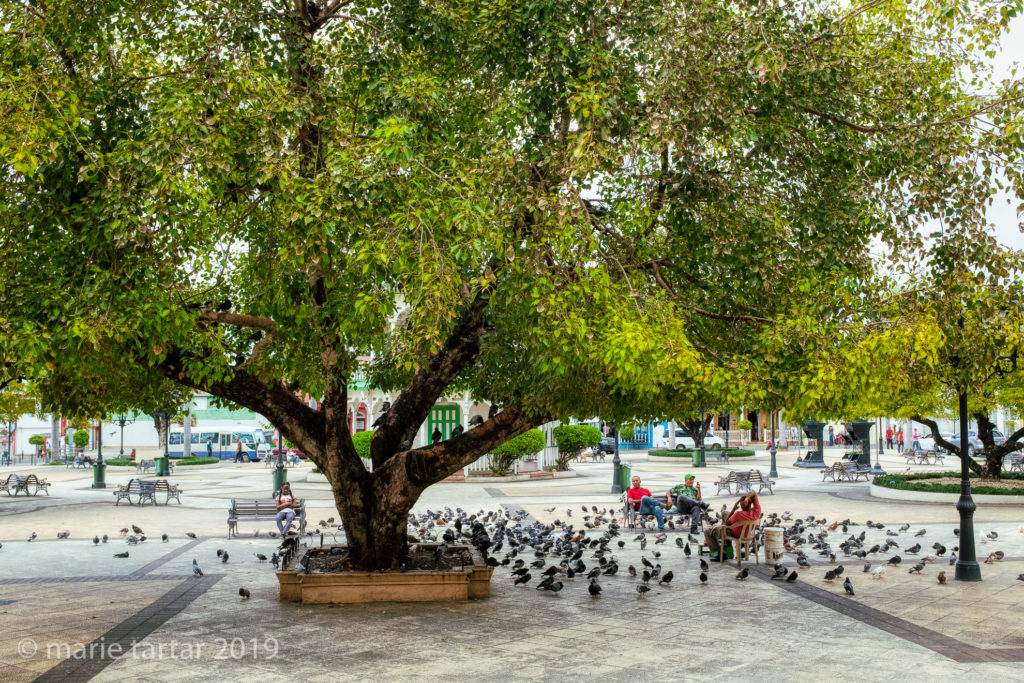

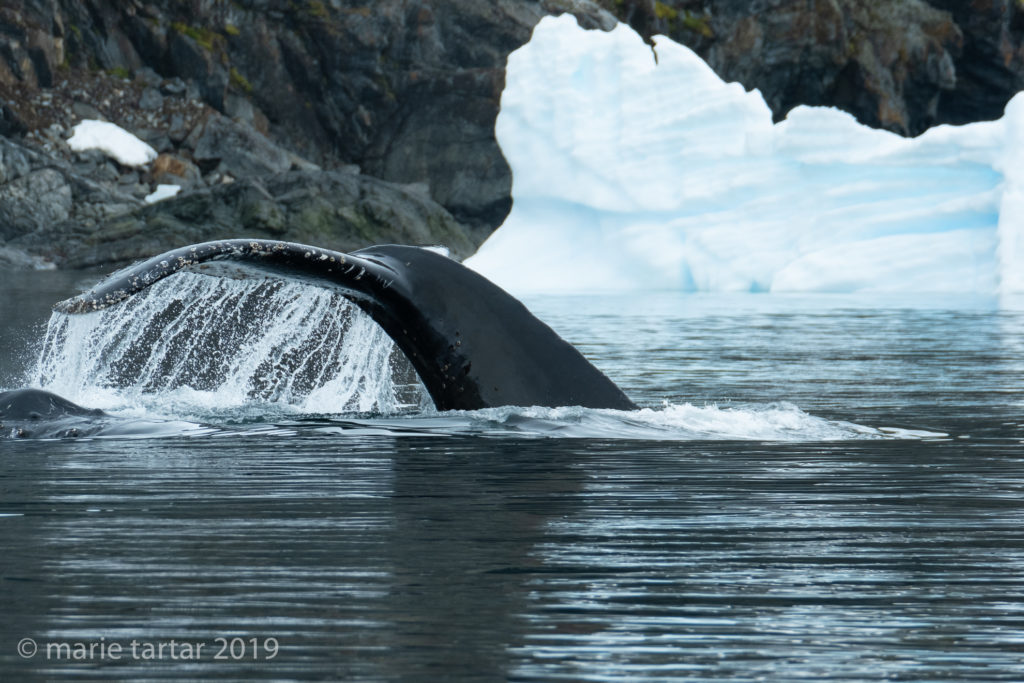
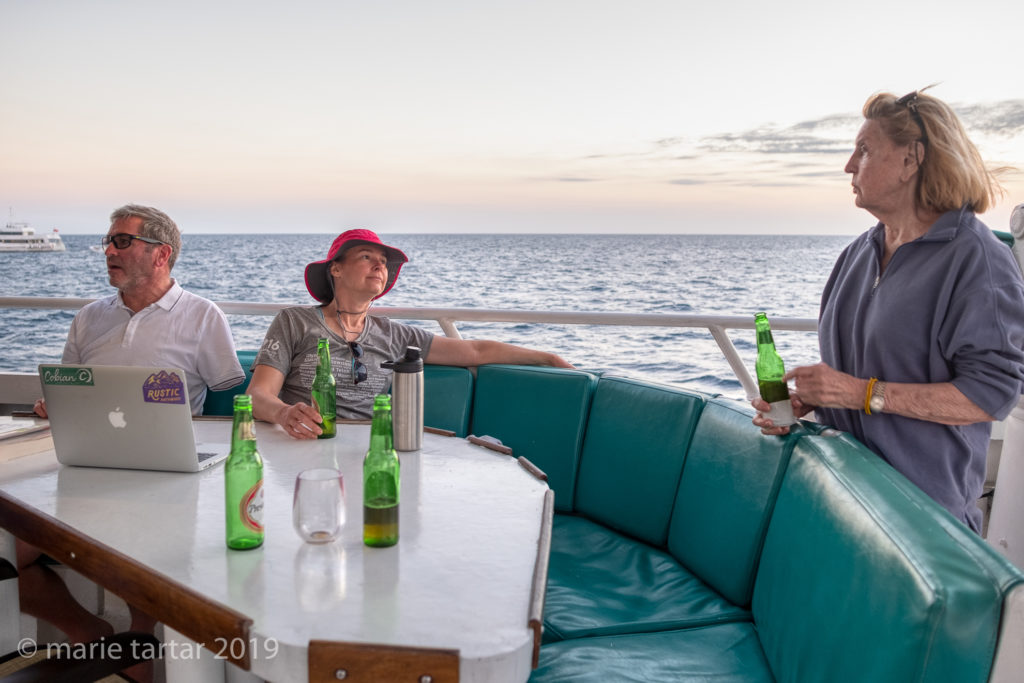
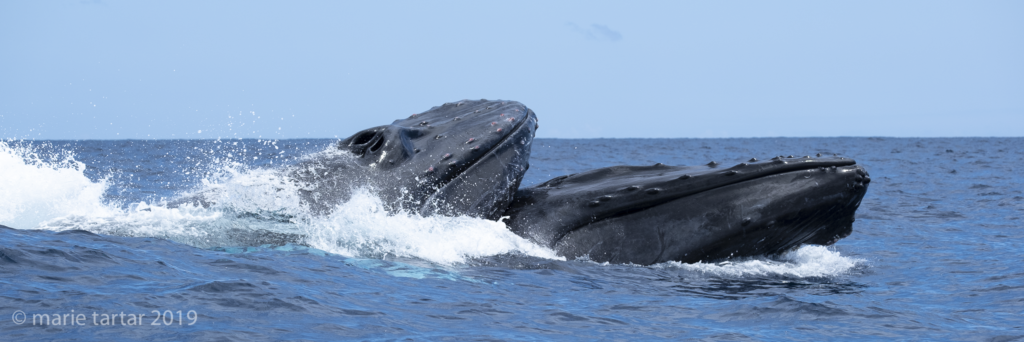
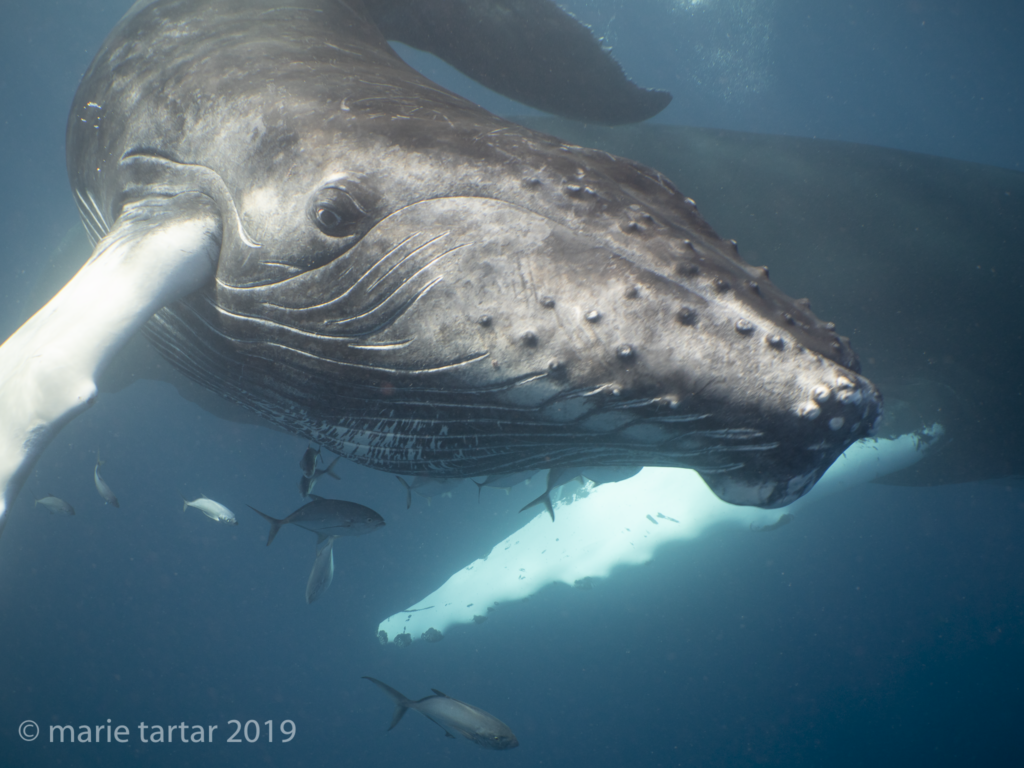
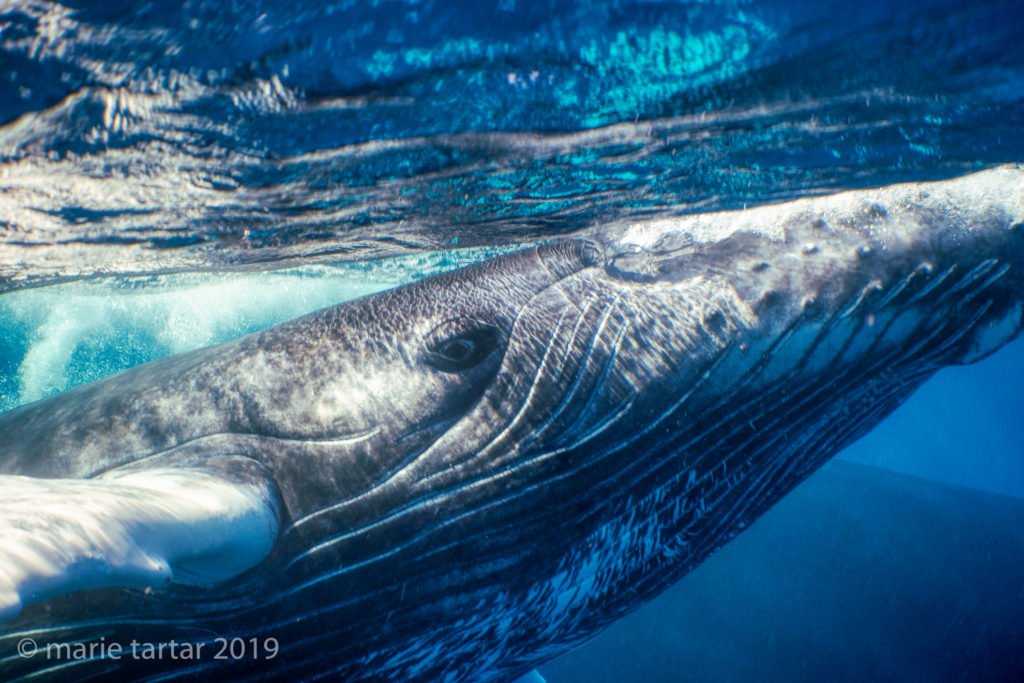
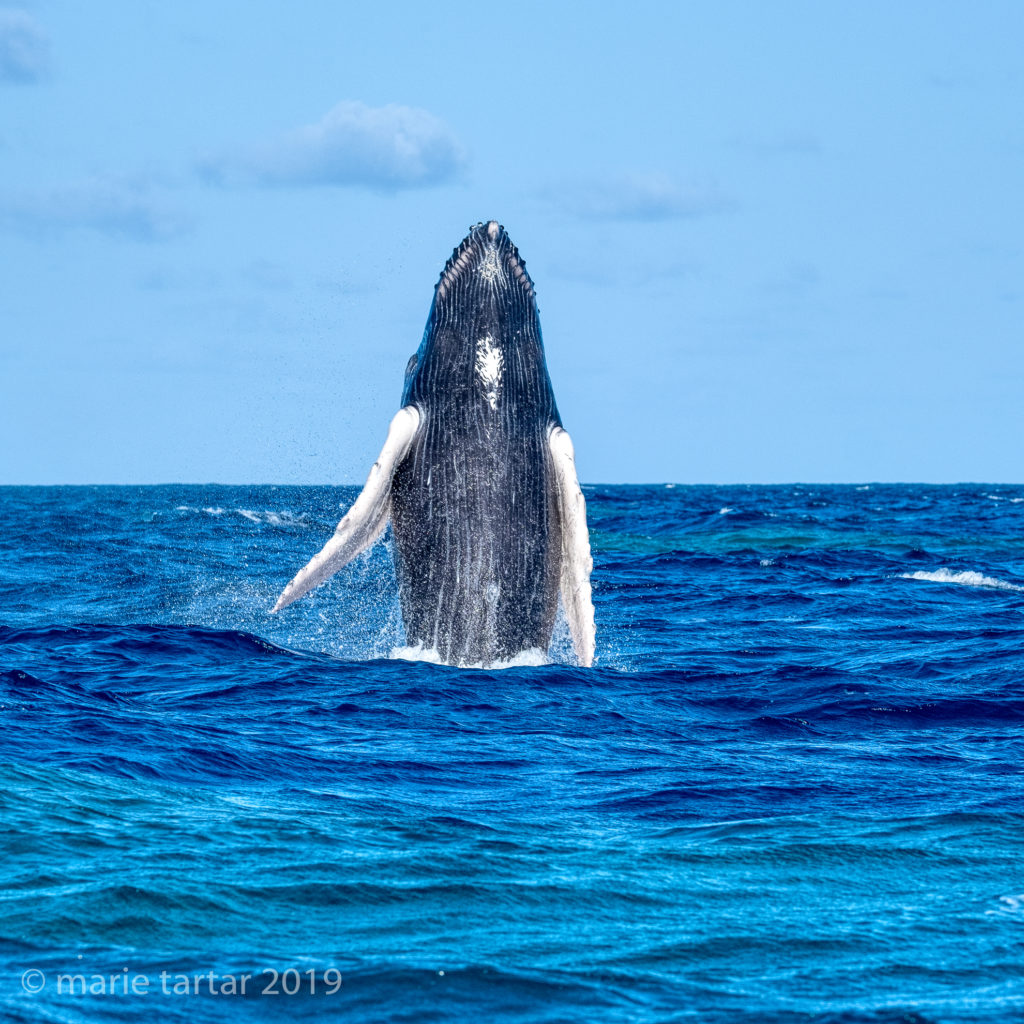
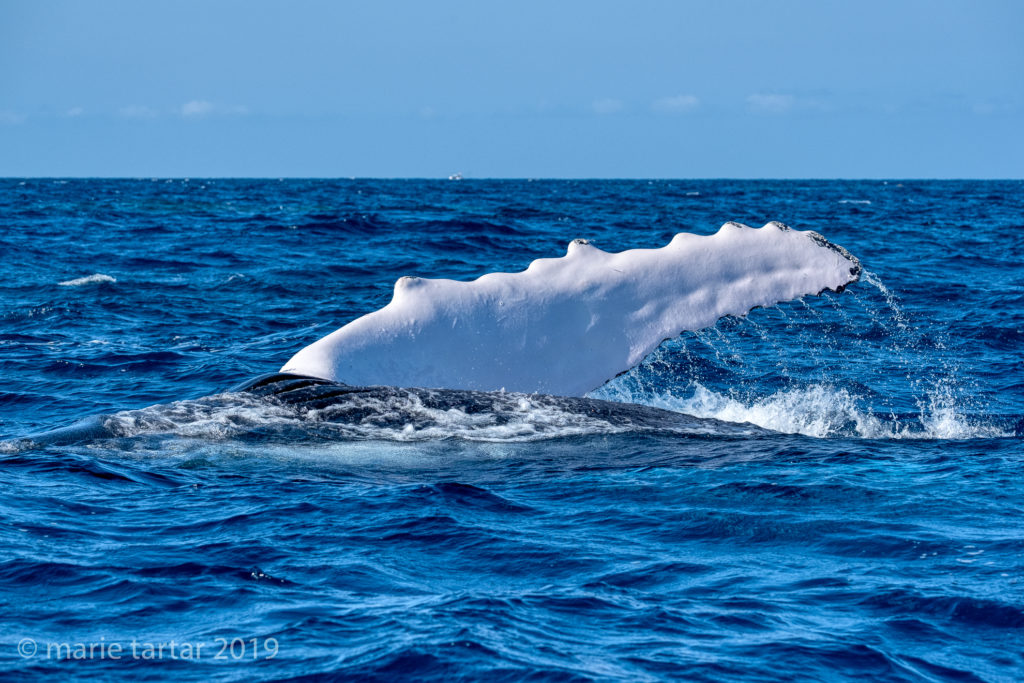
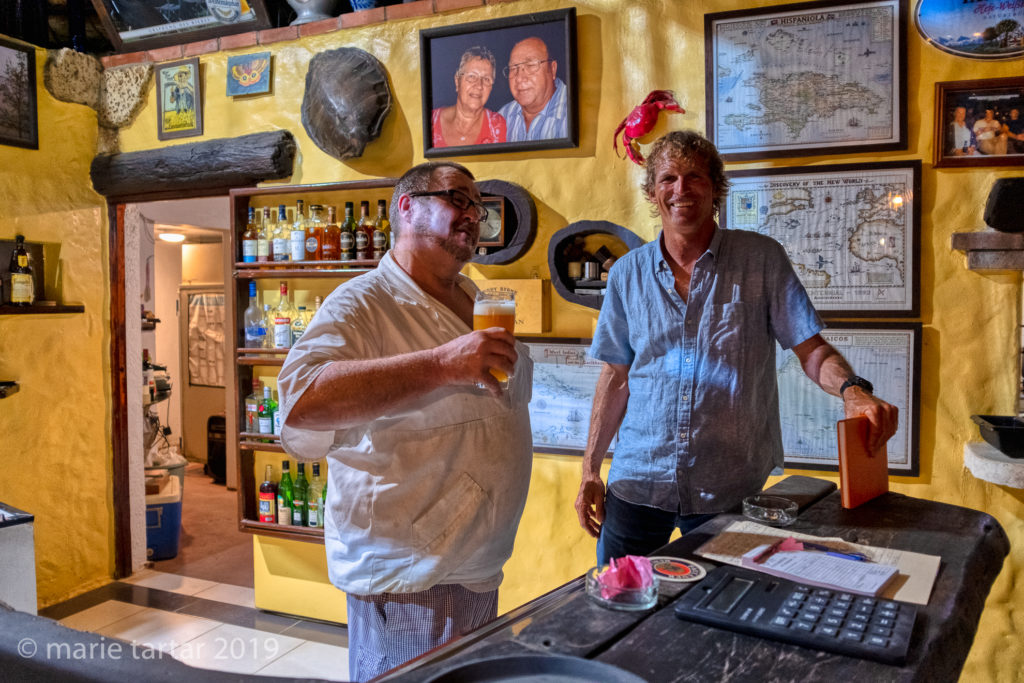
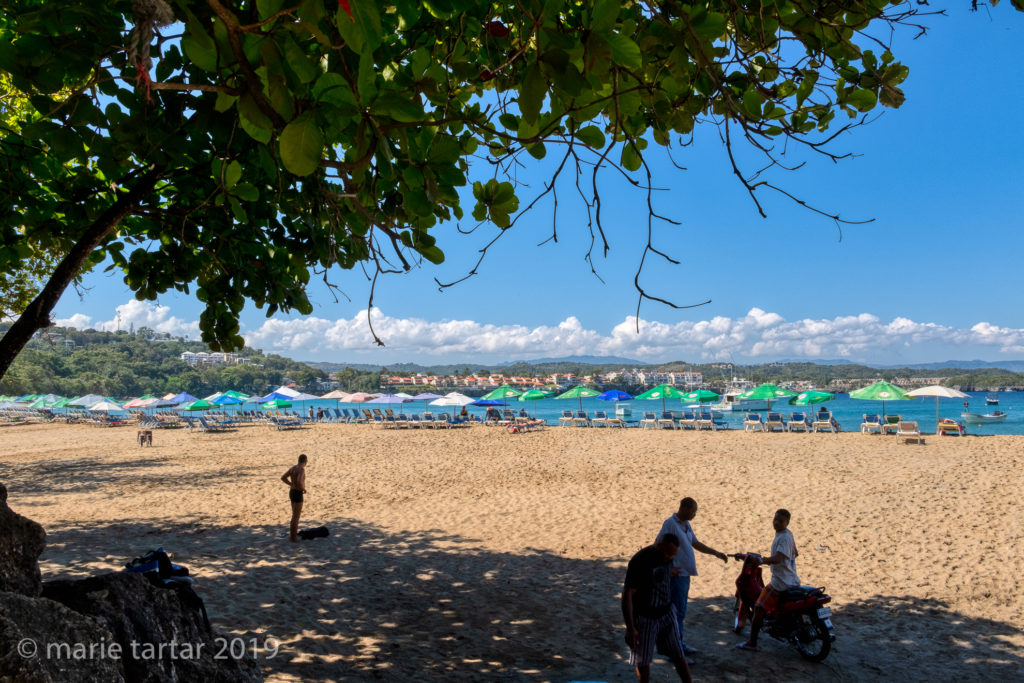
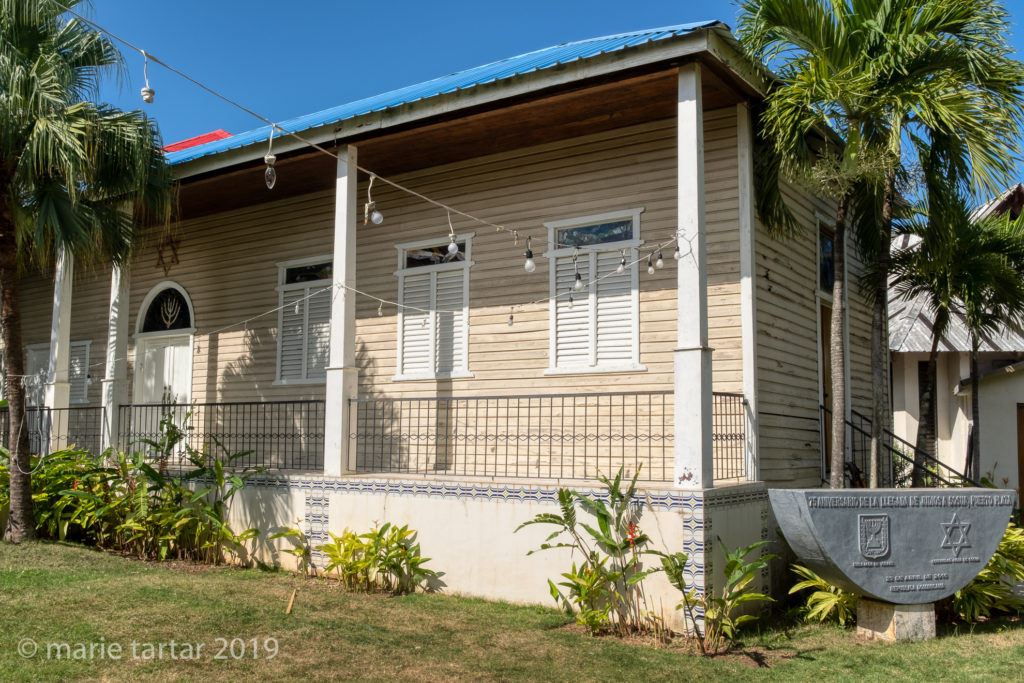
Hey Guys, Thanks for the post. Looks like you had better weather than I did last year. Great shots! I’m hoping to go back to the Silver Banks in another year or two. Tom lives here in Lancaster and stops by the dive shop occasionally. I would like to check out the BA IV. Last time I was on the TCA II. I like your zodiacs more.
PS. I just got back from a 10 day supermacro course with Mike Bartick at Crystal Blue Resort in Anilao, Philippines. This was probable the best course I’ve taken hands down. I’ll send you a post when i’m done.
Cheers,
Mark
Hi Mark,
We need to spend more time in the Philippines, so I look forward to seeing your take from there! Next year, Gene (Conscious Breath Adventures) will be doing his trips on one of the Seahunter fleet (yes, from Cocos). Pec and Fluke are his and will go with him and are definitely the nicest craft out there! Great family trip, I would think, too!
-Marie